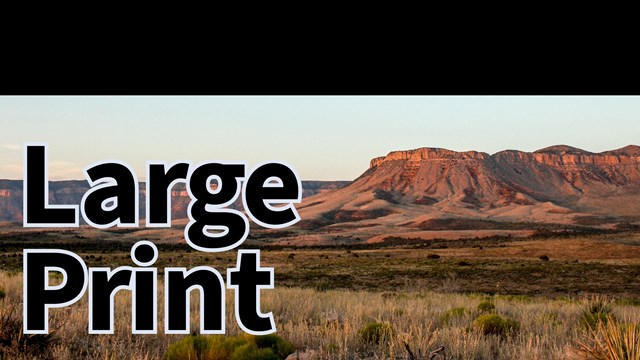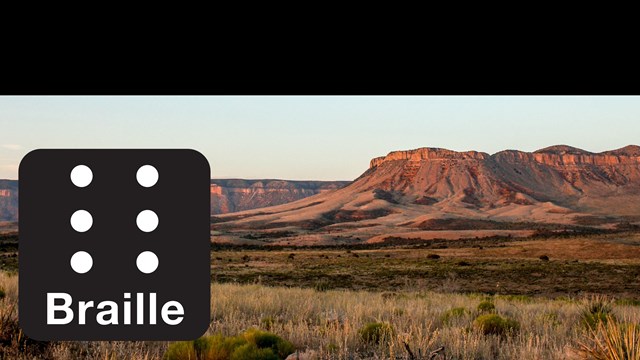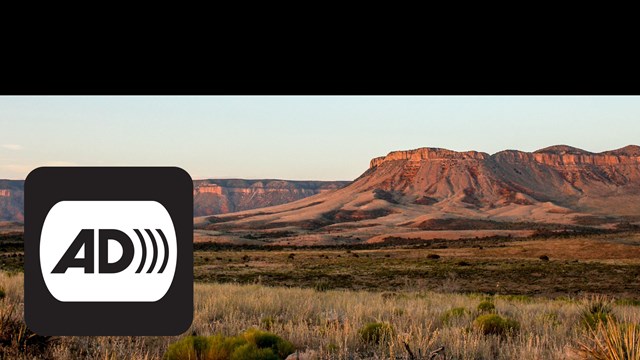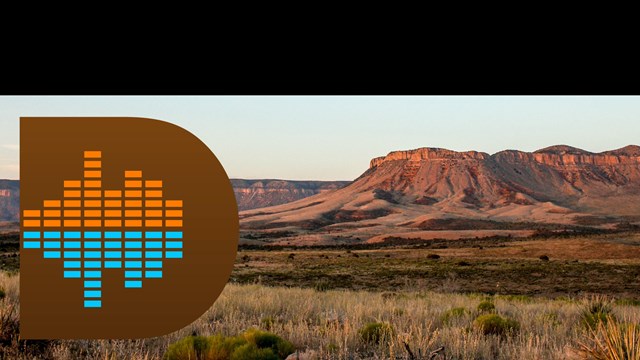
Large Print Version
Download this PDF brochure with large text and images. 
Braille Version
Download this brochure as a printable Braille file. Please note, you must have access to a Braille printer to make use of this file. 
Audio Described Version
Download a folder of audio files (13.3MB Zip). Open the files in your preferred mp3 player to listen to each section of the brochure. 
UniDescription Project: Parashant
Download the UniDescription App for access to other National Park Service brochures. Grand Canyon-Parashant National MonumentGrand Canyon-Parashant National Monument, a land area larger than the state of Rhode Island, epitomizes much of the “Wild West”—a vast, wild landscape of desert cactus and sheer canyon walls, soaring raptors and tall ponderosa pines, isolated cattle corrals and line shacks, lone cowboys, and rugged rock formations set against endless blue skies. Overview of the Front Side of BrochureThe front of the brochure includes a large color photograph, informational text, color photographs of the six ecosystems found within the monument, and historic photographs that appear in black and white. A Transitional LandscapeDescription:The top quarter of the image is a grey-blue cloudless sky that transitions to lighter shades of blue-gray as it descends to the skyline of the mesas in the distance. A flat sage-green and lavender-grey steppe valley with native grasses, yucca, and sagebrush bushes fills the bottom half of the image. In the distance above the valley are layers of sedimentary rocks forming the mesas and cliffs of the Grand Wash Cliffs. The cliff faces are highlighted in orange and yellow tones of the evening setting sun. Caption:The Grand Wash Cliffs, seen here bathed in the glowing light of sunset, illustrate the serene beauty of the cliffs, canyons, and valleys of Parashant. The national monument protects a wealth of features, natural and cultural, for scientific purposes and for the public to use and enjoy. Photo Credit: Todd H. Miller Related Text:Grand Canyon-Parashant National Monument is seen by few people. Deep canyons, mountains, and lonely buttes testify to the power of geological forces and provide colorful vistas to all visitors. At night the sky is resplendent with stars. Parashant features some of the darkest night skies to be seen anywhere in the continental United States. Related Text:From Native American cultures to the ranching way of life to today’s modern explorer, Parashant is a land of discovery, enchantment, and wonder. Here the wildlife is still wild and their habitats remain largely undisturbed. The variety of ecosystems provides a diverse richness of plant and animal species. Desert WashThe Mojave, driest of all North American deserts, gets less than 10 inches of rain a year. Snaking across this arid landscape, scoured desert washes carry the runoff after monsoon rains. Desert tortoises and Gila monsters actively forage after these refreshing storms. Deep-rooted plants grow along the washes, providing black-tailed jackrabbits with shady hiding places. Caption:Grand Wash between Pakoon Springs and Tassi Ranch Description:The top half of the image is a grey-blue sky that transitions to darker shades of blue-gray as it descends the page. The bottom half of the image contains a dry creek bed with checkered desert vegetation growing on each side of the wash. A creosote bush in the center of the image is labeled with a white number 2 inside of a small black circle. Layered in front of the image are three additional images of: a prickly pear cactus (labeled with a white number 1 inside of a small black circle), a desert roadrunner bird, and a desert tortoise. Joshua Tree ForestJoshua trees are characteristic Mojave Desert plants that grow up to 40 feet tall. Their prickly branches give many animals shelter, a food source, and nesting materials. As many as 25 bird species nest in Joshua trees. Scott’s orioles hang nests from branches, other birds build nests in foliage, and northern flickers peck nest holes in the trunks. Toppled trunks house insects that are important for creating the foundation of a complex food web. Caption:A Joshua tree near Pakoon Springs Description:The top half of the image is a grey-blue sky. The bottom half of the image contains a cluster of beavertail cactus. Layered in front of the image are three additional images of: a Joshua Tree (labeled with a white number 3 inside of a small black circle), a black-tailed jackrabbit, and a Gambel's Quail. Mojave Desert ScrubThis community’s spiny, succulent plants denote desert to most people. In rainy periods barrel cacti store water in their vault-like spiny bodies. Surviving long periods of no rain, they live up to 130 years. Rock-dwelling chuckwalla lizards also use their body’s store of water and fat during dry periods. They can wedge themselves into rocks by inhaling air, making it hard for predators to pull them out. Caption:Upper Whitmore Canyon Description:The top half of the image is a grey-blue sky. The bottom half of the image contains a beavertail cactus and a large barrel cactus in the foreground. A rocky desert peak of layered sedimentary rock, devoid of vegetation, is in the background. The beavertail cactus is labeled with a white number 4 inside of a small black circle, the large barrel cactus in the center of the image is labeled with a white number 6 inside of a small black circle. Layered in front of the image are three additional images of: a Desert paintbrush (labeled with a white number 5 inside of a small black circle), a Chuckwalla lizard, and an Antelope ground squirrel. Sagebrush SteppeThe sagebrush steppe is found on semi-arid plains and flanked by pinyon-juniper woodland (right). You will drive for miles through this multi-hued landscape of sagebrush, shrubs, and short grasses. Big sagebrush is the most common plant, and rabbitbrush and other plants also thrive here. The adaptable coyote hunts rabbits and other small animals that hide in the shrubs. Caption:Steppe country east of Mount Trumbull Description:The top half of the image is a grey-blue sky. The bottom half of the image contains sagebrush valley interspersed with few juniper trees in the foreground. A rocky desert peak of layered sedimentary rock, checkered with juniper trees is in the background. Layered in front of the image are four additional images of: Rabbtibrush with vibrant yellow flowers (labeled with a white number 7 inside of a small black circle), Big sagebrush, (labeled with a white number 8 inside of a small black circle) a coyote, and a Great Basin rattlesnake.
Pinyon-Juniper WoodlandPinyon pines and Utah junipers grow on plateaus and mountainsides above the steppe. Junipers can live over 1,000 years, yet they only grow 20 to 30 feet tall. Slow-growing pinyon pines germinate beneath the protective shade of other vegetation. Mature pinyon pines produce nutritious seeds (pine nuts) eaten by birds, rodents, and people. The birds and rodents cache some pine nuts for the winter. Their buried and forgotten seeds sprout into new trees. Caption:Pinyon-juniper growing on lava flow outcrops. Description:The top half of the image is a grey-blue sky. The bottom half of the image contains a forested hillside of pinyon-pine trees and juniper trees. An individual pinyon-pine in the center is labeled with a white number 9 inside of a small black circle, to the right is a cliff rose labeled with a white number 10 inside of a small black circle. Layered in front of the image are two additional images of a common raven and a Steller’s jay.
Ponderosa Pine ForestCooler, higher, and with more rain, the Colorado Plateau ecoregion supports ponderosa pine, Gambel oak, serviceberry, and New Mexican locust. This forest is home to turkeys, Kaibab squirrels, mule deer, and goshawks. Ponderosa pines can live over 900 years and can grow over 150 feet tall. Their thick bark is fire resistant and smells like vanilla. Periodic fires are essential to maintaining the health and vigor of ponderosa pine forests. Caption:Ponderosa pine forest on Mount Logan Description:The top half of the image is a grey-blue sky. The bottom half of the image contains a forest of Ponderosa pine trees. An individual pine in the center is labeled with a white number 12 inside of a small black circle. Layered in front of the image are three additional images of a Lupine (labeled with a white 11 inside of a small black circle), a mule deer, and a Mountain lion.
Historical PhotosImage 1 of 6: First InhabitantsCaption:Parashant is part of the ancestral homeland of the Southern Paiute. In rabbit skin robes, this circle dance ceremonial group celebrates their ties to the land and animals. Photo Credit: © Kaibab Paiute Tribe Description:A black and white photo of a group of two dozen Native people standing in a circle, all facing toward the center, dressed in rabbit skin robes. Image 2 of 6: Recent ArrivalsCaption:Beginning in the 1870s miners, loggers, and ranchers built homes and struggled to raise families and survive in this remote country. Some of their descendants still ranch in the monument. Photo Credit: National Park Service Description:A black and white photo of a ranch house, wooden corrals, and several horses. Image 3 of 6: LoggingCaption:Local stands of ponderosa pine provided building materials for early settlers’ homesteads and Mormon building projects. Economically significant logging began in 1876. Photo Credit: National Park Service Description:A black and white photo of an open-air wooden pavilion giving shelter to a small logging operation. A dozen people are posed for the photo underneath the pavilion. Stacks of lumber surround the area. Image 4 of 6: Copper MiningCaption:After an unsuccessful gold rush, copper mining took hold in 1873. The Grand Gulch was the most productive. Mules packed in tools and supplies until a wagon road opened to St. George, Utah, in the 1870s. Photo Credit: National Park Service Description:A black and white photo of three wooden structures, a loading tower, and a railroad track that were part of the Grand Gulch Mine. Image 5 of 6: Cattle RanchingCaption:Livestock grazing has been part of Arizona Strip culture since the 1850s. It continues as a part of the monument’s multiple-use management. A few fulltime residents still live in this remote area. Photo Credit: National Park Service Description:A black and white photo five cattle ranchers. Four men are on horseback, the fifth is leading a horse by a bridle. An old truck with a wooden box appears to the right of the ranchers. In the background are dozens of cattle in a corral. Image 6 of 6: PreservationCaption:A 2000 presidential proclamation set aside this national monument for its nationally significant natural and cultural features. It continues to attract a variety of scientists and recreational users. Photo Credit: William J. Clinton Presidental Library Description:A color photograph of President William J. Clinton (center-seated) prepares to sign proclamation creating new national monument. President Clinton was joined by (left to right) Congressman Ed Pastor, US Interior Secretary Bruce Babbitt, Congressman Sam Farr, Lake Meade National Recreation Area Superintendent Alan O'Neil and Field Manager of the Bureau of Land Management Roger Taylor. Overview of the Back of the BrochureThe back of the brochure is comprised of text, a large map of the monument, and color photographs. The top five sixths of the brochure is dominated by a large map, which shows the full acreage of the monument and includes roads, waterways, points of interest, and boundaries of adjacent parks, monuments, and reservations. Text sections are arranged to the right of the map and explain the service first partnership of land management, trip planning, and contact information. The bottom sixth of the page contains titles, informational text, and color photographs of six points of interest found within Parashant: Pakoon Springs, Tassi Ranch, Grand Gulch Mine, Twin Point, Whitmore Canyon Overlook, and Nampaweap. Map of Grand Canyon-ParashantThis page is a map of Grand Canyon-Parashant National Monument and the area around it. The map background is in shades of tan that show the relative contours of the surrounding area; Grand Canyon-Parashant is in green, continuing the contours within the monument boundaries. North is oriented to the top of the page. Important Information Text:This map shows only the major unpaved roads on the Arizona Strip. Over 6,000 miles of unpaved roads exist here, some suitable only for all-terrain vehicles. To travel roads not shown on the map, use the BLM Arizona Strip Visitor Map, available online and locally. Text:A Monumental Partnership. Here, in over a million acres of vast, remote, and sparsely developed landscapes, the Bureau of Land Management and the National Park Service have embarked on a monumental joint venture—to conserve the features and wild character of this remote place. The monument encompasses the lower Shivwits Plateau, an important part of the Colorado River watershed. The monument is designated an International Night Sky Province by the International Dark Sky Association for the Parashant’s astonishing and largely unimpaired night skies. Contact Information:Grand Canyon-Parashant National Monument Planning Your VisitThe Bureau of Land Management (BLM) and the National Park Service (NPS) invite you to experience the 1,048,321-acre Grand Canyon-Parashant National Monument. The Public Lands Information Center in St. George, Utah, offers exhibits, publications, and maps. Staff can answer your questions and update you on road conditions. Emergencies:Call 702-293-8998 to reach 24/7 emergency dispatch at Lake Mead National Recreation Area. Satellite phone service only. Respect Private Property:Some roads within the monument cross private land. Please respect owners’ property by remaining on the road. Leave gates as you find them. Getting Around:The only roads into the monument are unpaved, some are very rough. If you plan to travel on roads not shown on this map, you need the BLM Arizona Strip Visitor Map or topographical maps. The Arizona Strip map can be purchased at the Public Lands Information Center or at Pipe Spring National Monument. The Public Lands Information Center also has topographic maps. Tuweep and Toroweap Overlook:This area is within Grand Canyon National Park and subject to its regulations. No camping unless you already have a reservation and permit. Otherwise, day-use only, sunrise to 30 minutes after sunset, as permitted. Vehicle numbers and types limited. Tuweep - Grand Canyon National Park Regulations and Safety:Some regulations, including those for firearms, differ between NPS and BLM lands within the monument. Check each agency’s website or inquire at the Public Lands Information Center before you enter the monument.
GPO 2017: 398-30968 Last update 2017, Printed on recycled paper. Images of Points of InterestImage 1 of 6: Pakoon Springs
Caption:An island of lush trees and cattails reveal that flowing water is here. Pakoon is one of the monument’s largest springs but its water was impounded for years. Now it flows freely, allowing the landscape to return to a more natural state. Photo Credit: National Park Service/ Jeff Axel Description:Image of a desert valley with sparce vegetation captured from a high vantage point. In the center of the image is the distant lush vegetation of trees and riparian plants growing around the spring. Image 2 of 6: Tassi Ranch
Caption:Tucked in rocky hills beside a flowing spring, a rustic stone house and other ramshackle structures paint a vivid picture of life on a cattle ranch in the 1930s and 1940s. Photo Credit: National Park Service/ Tom Patterson Description:Image of a stone ranch house with a metal roof. A small add-on room appears to the right of the main structure. Large cottonwood trees fill in the background behind the ranch house. Image 3 of 6: Grand Gulch Mine
Caption:Economically valuable copper and silver were found here in 1871, attracting miners and settlers. Historic ruins like the adobe smelter and abandoned dump trucks pay silent tribute to the people who lived and worked here until the early 1900s. Photo Credit: National Park Service / Max Ramirez Description:Remains of a smelter constructed of adobe bricks surrounded by sparce desert vegetation. A dry hillside devoid of plants appears in the background. Image 4 of 6: Twin Point
Caption:A rough road through pinyons and junipers reaches Twin Point. Its views into the Grand Canyon reveal a fascinating geological story and its remote location offers a profound sense of solitude. Photo Credit: National Park Service / Max Ramirez Description:In the distance an orange and yellow mesa is lit by the light of the setting sun. In the foreground is a cliff edge with sparce desert plants also lit by the glow of sunset. Image 5 of 6: Whitmore Canyon OverlookCaption:A very rough and steep dirt road winds down a lava flow and ends in an area with spectacular views of the Grand Canyon and the Colorado River. Photo Credit: National Park Service / Darla Sidles Description:A single hiker stands in the bottom of a canyon looking out across the vista. Cliff walls of reddish sedimentary rocks rise on each side of the river flowing at the bottom of the canyon. Image 6 of 6: Nampaweap
Caption:A short trail (less than one mile) takes you to a petroglyph site, one of the largest on the Arizona Strip. Hundreds of images provide clues about the lives of early native residents. Photo Credit: National Park Service / Kyle Voyles Description:Several petroglyph figures of rock writing are carved into a dark gray basalt boulder. AccessibililtyGrand Canyon-Parashant National Monument is a remote and isolated area with 1,200 miles of dirt, gravel, and rocky roads. There are only a few trails that are seldom used. The trails do not meet accessibility standards due to topography. There is no developed infrastructure, no services, and no cell phone service. The monument is undeveloped other than rough unpaved roads and a few new vault toilets. Surfaces in the monument are unimproved and in a natural state. This means rocky terrain or loose soil and sand. For persons with disabilities who can drive or ride as a passenger, "side-by-sides," also known as utility terrain vehicles (UTVs), are a popular way to experience the monument on roads that vary from smooth to rock-crawling. Roads reach scenic viewpoints such as Twin Point, Whitmore Canyon Overlook, Mount Logan, as well as historic sites next to the road. Accessible Vault RestroomsThere are several accessible vault toilets available at the following locations within the monument. The vault toilets themselves are accessible, but do not have hardpacked or paved trails from the parking area to them at this time.
Interagency Public Lands Information Center
In 2017, the National Park Service completed a seven-year action plan to meet the requirements of the Americans with Disabilities Act (ADA) and the Architectural Barriers Act Accessibility Standards (ABAAS). The Self Evaluation Transition Plan (SETP) lists key park experiences that every person, regardless of their ability, should have the opportunity to experience. Monument staff are working to increase accessibility where possible. More InformationGrand Canyon-Parashant National Monument is one of over 400 parks in the National Park System. To learn more about national parks and National Park Service programs in America’s communities, visit www.nps.gov. Start your journey by getting information at the Public Lands Information Center, 4001 East Aviator Drive, Saint George, UT 84790. Contact Information
|
Last updated: July 29, 2025

